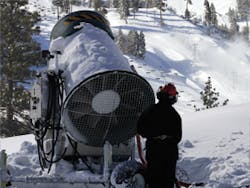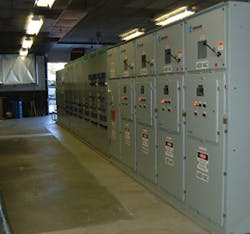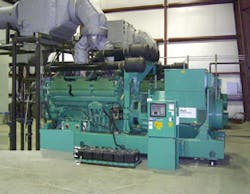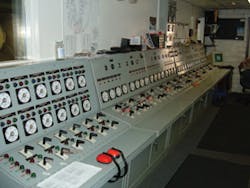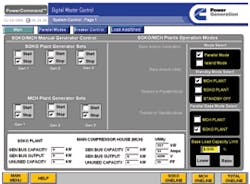Southern California has the mountains for skiing, but the climate can be fickle when it comes to supplying enough snow to keep a ski resort open. Rather than relying on the whims of the weather, one resort has chosen an innovative solution: a microgrid able to power the resort’s snowmaking equipment and transform up to 8,000 gallons of water per hour into a localized blizzard.
For Cummins Power Generation Inc. based in Minneapolis, MN, putting together a system with enough power to control the mountain’s atmosphere was no simple task. First, consider the logistics of designing for a peak reaching 8,000 feet above sea level. Then, add a scenario that starts with a set of three generators at the base of the mountain that parallel with each other. Nothing unusual about that. But how about another set at the top of the mountain (roughly a mile away) that also will parallel with each other? Worse yet, prepare for times when those two sets of generators must actually parallel with each other across transmission lines spanning a mile. Finally, don’t forget the customer’s request for the highest flexibility possible in load distribution and control, without undue risks from operator errors.
The customer in this case is Snow Summit, a ski resort nestled high in California’s San Bernardino Mountains about two hours from Los Angeles. Snow Summit opened in 1953, and introduced snowmaking to local skiers in 1964. At that time, the resort had just one chairlift. Since then, a lot has changed…
Local Utility: 2.5 MW Versus Distributed Energy: 12 MW
Today there are 14 lifts serving roughly 18 miles of ski trails throughout 250 acres. The power demands for such growth couldn’t be supplied by the local utility, which offers a maximum of 2.5 MW (just enough to run the chairlifts, lodge, bars, restaurants, and shops). In fact, Snow Summit realized the need for its first onsite generation facility in 1979.
By the 2000s, the benefits of boosting their snowmaking capability by 50% made it feasible to upgrade onsite power to a new high of 12 MW. It was a major step, and, along with providing electricity for air compressors, water pumps, fan guns, and compressed air-powered guns, the new microgrid would improve operating flexibility and reliability.
The completed system has a total of six Cummins Power Generation 2-MW prime power diesel generators (model DQLA), powered by 78-liter Cummins engines. Three of the generators are located at the bottom of the mountain, and the other three are at the top. To accommodate the resort’s widespread equipment, Cummins designed the microgrid as a medium-voltage distribution loop with various load taps along 3 miles of underground power lines.
Power is guided by transfer switches, digital paralleling equipment, and controls, with data communications between the two sites traveling on a high-speed fiber optic network. Beyond powering the snowmaking equipment, this system can provide resort-wide power in the event of utility failure and allows equipment to be taken offline for maintenance.
Keeping the Skies Blue
The project took about five years, and the hardest part wasn’t in the design or construction, recalls Paul O’Hara, General Manager of Power Generation at Cummins Cal Pacific. “The biggest problem was getting the air district to allow us to run diesel engines,” says O’Hara. “These kinds of projects are rare in California because there is a basic prohibition against running any engine in a stationary application. The local district views these operations as ones that should use electricity and not burn fuel.”
O’Hara says that to satisfy the district, almost as much money was spent for controlling air pollution as for the generators themselves. The pollution after treatment had to be a one-off special design specifically for this project. Due to operating hours of roughly 1,000 per year, the generator sets have emissions control equipment based upon a combination of continuously regenerating particulate traps and a selective catalytic reduction system.
Designing around the startup loads of the air compressors was another critical point in the project. With 10 air compressors between both the upper and lower sites, Cummins began with a sizing analysis to make sure they could start the compressors without taxing the generators.
“With a utility you have the muscle of many hundreds of very large machines creating electricity to handle intermittent momentary overloads,” explains O’Hara. “But in a microgrid, you have to take it out of your engines, and that can be a problem. Those air compressors have a startup demand that can be as high as two or three times more than the specified power consumption rating.”
Cummins engineers worked closely with Snow Summit to program startup sequences that would prevent overloads while maintaining fast response time for the compressors.
Controlling Complexity Over Great Distances
According to Dave Matuseski, systems engineering manager at Cummins, avoiding overloads was just one of the many unique aspects in
the microgrid’s configuration. “It started with a two-phase approach, and in both phases we had a set of generators at the bottom of the mountain that parallel with each other and another set at the top of the mountain which is roughly a mile,” says Matuseski. “At times, those two sets of generators parallel with each other over a great distance and that adds a lot of complexity to the design.”
One of the main issues was running the bottom set of generators while controlling the load to maintain a minimum of power up and down the transmission lines. With top to bottom loads constantly changing, the system had to dynamically adjust which generators took the load so the power never exceeded the maximum capacity of the transmission lines and cable. Even though the system has protection parameters in place, the controls will separate the two generation plants and put them in the island mode if power on the lines comes too close to their maximum.
Island mode disrupts the snowmaking capability, and bringing some of the equipment back to peak operations can take man-hours, resulting in lower snow volume. “We often heard the term “white gold,” and for Snow Summit everything revolves around their ability to make snow,” recalls Matuseski. “That’s what keeps them in business.”
Keeping the white gold on the slopes during the first phase, involved maintaining the 1979 Caterpillar generators operating in parallel with the new units atop the mountain, so Cummins had to develop a way to parallel their units with the Caterpillars. Due to control limits in the older units, the bottom generators were set permanently in isochronous (frequency of electricity generated is “flat” or constant) mode. “We went through a whole season with the top always in the govern mode,” explains Matuseski. “They couldn’t be flipped back and forth because we had no way of controlling the Caterpillars.”
“In particular,” he adds, “what we did was respond slower than real time to fluctuations on the transmission line, rather than respond within milliseconds and create an oscillation rate that caused the gensets at the bottom to shut down. We settled on about three seconds, and both the top and bottom generator sets stayed on and we were able to control the load properly while we were tuning our feedback loop.”
With completion of the second phase, Cummins gave Snow Summit more flexibility for controlling the generators. “Typically, the bottom siteThese sensitive operations depend upon custom switchgear composed of medium voltage equipment with an integrated control system and touch screen mechanical interface. The touch screen shows the whole system from either the top or the bottom and it’s also accessible as a remote interface via a Web page. “We provided Snow Summit with the ability to have as much flexibility as possible in changing their modes,” says Matuseski. “They could decide to just start the bottom and get everything warmed up and then push a button on the controls to start the top generators.”
He continues, saying they would then “synchronize the top with the bottom and they have the flexibility to decide to make the top generators the isochronous load share and let the bottom govern the operations.”
Balancing Safeguards With Flexibility
With several operators controlling the system at any given moment, Cummins wanted as many safeguards as possible, so an operator couldn’t execute a command that would have catastrophic results. However, Snow Summit wanted a lot of flexibility. Obviously, there had to be trade-offs between maximum flexibility and reducing the risk of error. The team had to look into every scenario and work closely with the Summit’s staff. For example, it was desirable to have the option to open and close certain breakers that could cause the system to shut down. Cummins reprogrammed the system so those breakers would not actuate a shutdown.
For maintenance or other needs, the system does have a shutdown mode to take one of the plants offline and have the other plant synchronize with the local utility. Regarding maintenance, O’Hara describes the after treatment system as a key maintenance point that requires regular monitoring of the differential pressure across the particulate filters. For the generators, maintenance requires them to be taken out of service after several hundred hours for oil and filter changes.
During such interruptions, an option for a closed transition back to the utility allows operators to keep ski lifts and other equipment running. If the utility fails, the system can run as a backup generation unit, and in the event of a forest fire or other disaster, the resort can even supply power to the local utility. Disasters haven’t materialized yet, but the employees have been fully trained and there’s a complete stock of parts plus everything necessary to keep the system going even if roads become inaccessible.
The Price of Climate Change
Ultimately, the project is a success, says Bob Sokolowski, Snow Summit’s utilities and planning manager. But this is one form of climate change that comes with challenges before and after construction. “A project like this is complicated, and my advice is if you could buy the power, do it,” says Sokolowski. “Our issue is the volatility of diesel fuel, and when you’re producing your own power, you’re much closer to fluctuations in prices.”
In full operation the generators use about 7,200 gallons of diesel per day or about 600 per hour. Nonetheless, Snow Summit’s investment in emissions controls keeps the skies blue, and the system provides more than enough reliable power to keep white gold on the slopes for the foreseeable future. That gives Sokolowski time to improve operating efficiencies that will reduce power and fuel demands.
One possibility on the horizon involves new air compressors that deliver more water to snowmaking equipment, yet use the same amount of air as previous models; although, it’s unlikely that southern California’s skiers will notice. They’re more than willing to pay $53 for a day’s worth of skiing on what Snow Summit confidently advertises as: “Real Snow Guaranteed.”